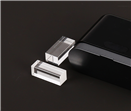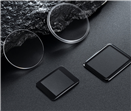
Time:2025-05-22
The term sapphire glass may not be unfamiliar to many people, especially in watches, smartphone screens, and various precision instruments. It has won widespread attention and application for its unique charm and performance. As a multifunctional special glass, it has demonstrated extraordinary value and potential in the fields of optics, electronics, and industry.
Sapphire glass is named after its similarity in chemical composition and physical properties to natural sapphire. Unlike rare gemstones in nature, it is a synthetic product mainly formed by the crystallization of high-purity alumina at high temperatures. This single crystal material has high hardness, wear resistance, and transparency, making it stand out among many high-performance material applications.
In the field of optics, sapphire glass is particularly widely used. Its Mohs hardness is 9, which means it can maintain durability in various high wear environments. In addition, sapphire glass has high transparency in the visible and near-infrared spectral ranges, which makes it widely used in high-precision optical devices and high-resolution displays. For example, in camera lenses, night vision infrared and far-infrared sights, night vision cameras, and other instruments, sapphire glass is used as a lens and window material, which not only provides clear and stable images, but also ensures the long-term stability and reliability of the equipment.

In the field of electronics, sapphire glass has also demonstrated extraordinary performance. Due to its low conductivity and high thermal conductivity, it is widely used in semiconductor manufacturing as an insulating substrate and protective cover material. In electronic devices such as high-power lasers, various optical prisms, optical windows, UV and IR windows, and lenses, the high thermal conductivity of sapphire glass helps with heat dissipation, ensuring stable operation of equipment in high temperature and high electric field environments. Meanwhile, its excellent chemical stability and corrosion resistance give sapphire glass significant advantages in the packaging and protection of electronic devices.
In the industrial field, the application of sapphire glass is also extensive and profound. Due to its high hardness and wear resistance, it is used as a window and protective material for various precision instruments and meters. In high-precision instruments such as navigation, aerospace, and aviation, the high transparency and impact resistance of sapphire glass ensure the safety and reliability of equipment in extreme environments. In addition, in high-pressure and high-temperature environments such as oil well drilling, the application of sapphire glass rupture rings and blasting discs has also demonstrated its unique performance advantages.
In addition to the above-mentioned application fields, sapphire glass has also shown great potential in the field of medical beauty. For example, in sapphire hair removal devices, medical grade cold light technology is used with sapphire lamp heads and window light guides. Compared with ordinary hair removal devices, the high transparency of sapphire can allow light waves to penetrate deep into the hair follicle roots of the skin, achieving a more thorough and efficient hair removal effect. At the same time, the sapphire lamp head can also soften the skin while removing hair, and long-term use can make the skin fairer and more delicate.
In the era of 5G high-speed communication, the consumer electronics industry has ushered in new changes. Smart wearable devices such as smartphone screens and smartwatches have higher requirements for the durability, transparency, and aesthetics of materials. Sapphire glass has become one of the materials for these device screens due to its hardness and scratch resistance. Meanwhile, with the continuous development of wireless charging and signal transmission technology, sapphire glass has also shown great potential in the field of shell materials for consumer electronics products. The characteristics of strong electromagnetic wave penetration, good insulation, and fast thermal conductivity make it an ideal choice for consumer electronics products.
Sapphire glass, as a multifunctional special glass, has demonstrated extraordinary performance and broad application prospects in the fields of optics, electronics, and industry. The high hardness, wear resistance, and transparency make it one of the outstanding high-performance materials.






Tel
Mobile phone
Customer service
TOP